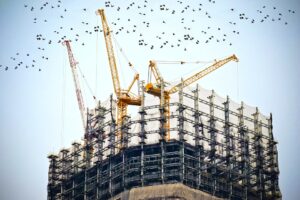Workers in the construction and offshore drilling industries encounter on-the-job risks daily. Most people know that construction and maritime work are dangerous.
Many accidents and injuries happen to people in these fields working on scaffolds. One thing that makes scaffolding so dangerous is the height of some scaffolds, which can be hundreds of feet in the air.
Scaffolding safety is a priority because workers handle building materials, use electrical equipment, and drill and operate machines on scaffolding.
Some scaffolding hazards on a construction or oil rig project include falling objects, working with dangerous machines, and electrocution.
What Is a Scaffold?
A scaffold is a temporary platform workers put in place on construction sites to stand or sit on when working above the ground. Scaffolding is essential to construction. Scaffolding is sometimes constructed on the outside of buildings during renovations to allow pedestrians to walk underneath. Scaffolds are erected offshore or at sea to perform maintenance or make repairs to offshore oil rigs. Painters, miners, bricklayers, and many other professionals use scaffolds to help them reach certain places they cannot reach by lifts or by using a ladder.
Are Scaffolds Safe?
If crews do not set up or use a scaffold properly, it can become very dangerous and potentially lead to deadly accidents.
The U.S. Occupational Safety & Health Administration (OSHA) provides and enforces safety regulations for the construction industry.
OSHA regulations outline common scaffolding hazards and provide safety regulations to protect workers. Not setting up scaffolds correctly is OSHA’s third most cited violation.
In one recent year, OSHA gave out almost 4,000 citations for the improper set-up of scaffolds. The agency believes that over 2 million construction workers use scaffolds to do their jobs, which is 65 percent of the entire construction workforce.
While many people have received training to use scaffolds, the Bureau of Labor Statistics (BLS) reported that 72 percent of workers still experienced injuries from using scaffolds.
Most reported injuries from scaffold accidents happened due to the scaffold’s planking, losing support, workers falling off, or people below getting hit with falling debris.
OSHA has strict requirements to identify scaffolding hazards and help ensure worker scaffolding safety. For example, scaffolds are required to support the entire weight of the structure and four times the planned load.
Guardrails must be installed on all sides and ends of the platform, and suspension ropes must support the planned load at least six times.
OSHA ensures that individuals nationwide who use scaffolds use safety equipment and inspect their scaffolds.
Despite OSHA’s efforts, some companies still choose not to provide their employees with protective equipment and scaffold safety training. Without safety standards, more scaffolding-related accidents will continue to happen.
What Happens if Offshore Companies Do Not Follow OSHA’s Scaffolding Requirements?
Financial penalties are likely if an offshore company does not follow OSHA’s scaffolding requirements. Unfortunately, some businesses ignore OSHA’s requirements or find ways around them.
This is usually because the employer wants to cut costs, save money, or reduce downtime, which can put workers in hazardous situations.
Since construction and oilfield workers work in some of the most hazardous industries, they may falsely believe their employers are looking for their safety.
However, this is not always the case. As a result, scaffolding accidents have become one of the most common types of construction accidents in America.
Scaffolding Accidents in the U.S.

While scaffolding is used throughout the country and worldwide, Texas frequently uses scaffolds to add new projects to its ever-changing and growing communities.
Other American states experiencing housing market surges also use scaffolds, which may increase scaffolding accidents.
Here are a few dangerous scaffolding accidents that occurred in Texas as well as other states around the United States in past years:
- After falling from the Kiewit Offshore Project, a scaffolding worker was found in the La Quinta Channel in Corpus Christi, Texas. He died from the fall.
- When winds began to pick up, four people were on a scaffold in Rockford, Illinois. They noticed that the scaffold had started to detach from the building, so they got off the structure immediately. Fortunately, no one was hurt, but people ran for their lives.
- Two construction workers suffered severe injuries after a scaffold fell at their construction site in Pittsburgh, Pennsylvania. The scaffold even crushed a car.
- Three people suffered injuries in New York City as it began to pour rain. A construction worker and two pedestrians suffered injuries when part of the plywood construction wall fell near Times Square. This led the company to receive several violations and a stop-work order.
- One of the worst scaffolding accidents occurred in Willow Island, West Virginia. Falling concrete caused a scaffold to collapse. As a result, more than 50 construction workers died.
Most Common Scaffolding Hazards
Scaffolding accidents caused 60 deaths and almost 5,000 injuries across the U.S. Falls are one of the main reasons these injuries and deaths occur, as falls make up 25 percent of fatalities among scaffold-related deaths.
Even if a worker survives a scaffold accident, they might need costly medical treatment and suffer lifelong disabilities.
Other common scaffolding hazards include:
- Collapse
- Slips and Trips
- Falling Objects
- Electrical Hazards
- Inadequate Training
- Unstable Foundations
- Guardrail and Toe Board Issues
- Communication Lapses
While employers believe they are cutting corners to save money by not following the safety measures required by OSHA, they can lose up to $90 million when a scaffolding accident occurs.
Injured workers and their families also stand to lose a lot in financial and intangible losses.
Common Causes of Scaffolding Accidents While Working Offshore on an Oil Rig or in Construction
There are various causes of scaffolding accidents because every single accident is unique.
The following are some common causes of scaffolding accidents:
- Explosions and fires
- Defective equipment
- Improper assembly
- Scaffold support failing
- Slip and falls
- Lack of guardrails
- Slippery surfaces
- Falling objects and debris
- Electrocution
- Scaffolding collapse
- Wind, rain, snow, ice
- Hazardous substances
- Not enough fall protection
- Overloading and too much weight
- Drowning
When you face injuries caused by an accident involving scaffolding on a construction site, you need an experienced lawyer to help you recover compensation.
While proven safe when installed correctly, scaffolding can still be dangerous for construction workers. Protect your rights today by discussing your legal options with an offshore construction attorney.
Common Scaffolding Accident Injuries
Since a scaffolding platform helps workers access heights that are normally too high, scaffolding accidents typically have a serious risk of severe injuries or even death..
The most common types of scaffolding injuries include:
- Broken or fractured bones
- Amputation or loss of limbs
- Traumatic brain injuries or skull injuries
- Spinal cord injuries
- Lacerations
- Paralysis
- Brain bleeds
- Organ injuries
Most scaffolding accident injuries are considered catastrophic, resulting in serious injuries that happen unexpectedly and may result in permanent disabilities.
When someone is severely injured in a scaffolding accident, they likely cannot work again or perform their normal daily tasks. Therefore, they may need ongoing daily assistance and care for the rest of their lives.
Getting proper compensation for a catastrophic injury is challenging, so victims need the right legal assistance.
Who Is Liable for a Scaffolding Accident?
Determining who is liable for a scaffolding accident requires an investigation. Finding fault in a scaffolding accident depends on the circumstances and the evidence.
A scaffolding accident attorney will investigate who was responsible for building the scaffold, how the accident happened, and whether the injured person was a worker or a pedestrian.
Different people and companies, including the employer, can be liable for a scaffolding accident. The contractor who built the scaffolding, the manufacturer of the scaffolding parts, or the property owner can all be parties to a scaffolding accident lawsuit.
An experienced and skilled scaffolding accident lawyer will review your case and determine who is liable for your injuries.
Evidence, such as police reports, medical records, witness statements, photos from the scene, video footage, and engineering records are necessary to build a case against the responsible parties.
How to Prove Negligence in a Scaffolding Accident
To have a successful personal injury case, you must show negligence in some way.
Here is how you can show proof of negligence in a scaffolding accident case:
- The defendant (responsible party) owed you a duty of care, which was most likely to keep you safe and out of harm’s reach
- The defendant (responsible party) breached their duty of care by failing to keep you safe and injury-free
- This breach caused the accident, which led to your injuries
- Because of this breach, you have damages and losses to the defendant’s negligent behavior
While it may sound easy to prove negligence, it can sometimes become difficult. The easiest factor to prove is that the victim has damages and losses, but the hardest factor is that the defendant was responsible for these damages and losses.
A legal professional will use their background, skills, and knowledge to ensure that negligence is proven and the responsible party is held accountable for their carelessness.
The Damages You Can Claim for Your Scaffolding Accident
Many different damages may occur due to your scaffolding accident. When deciding what damages you have, think about the pain, suffering, and accumulating costs you are experiencing now. This may include economic and non-economic damages.
Economic Damages
Economic damages include medical treatment, surgeries, lost income, physical therapy, occupational therapy, counseling, home modifications, services for daily tasks, and more.
Non-economic Damages
Non-economic damages include pain, suffering, loss of happiness and enjoyment, loss of companionship, trauma, and more.
Wrongful Death
If your family member, partner, or loved one died in a scaffolding accident, you may file a wrongful death lawsuit instead. This will ensure that the responsible party is accountable for this horrific event that caused the death of a loved one.
Nothing can be as traumatic as the unexpected passing of a loved one, especially due to someone else’s negligence.
You can ensure they are accountable for their actions and required to pay for funeral and burial expenses, the earned income the deceased is no longer receiving, and the loss of their support and companionship.
Have a Professional Offshore Construction Accident Lawyer in Your Corner

Offshore employers are aware of the dangers associated with this type of work. Companies are also well aware of the risks of their business and know that they must work to keep each of their employees safe and hazard-free when they are on the job.
Unfortunately, that does not always happen, and scaffolding accident attorneys must step in and hold them accountable.
If you have recently experienced an injury from a scaffolding accident and are unsure if you have a viable case, call an offshore construction accident attorney at the Wyatt Law Firm today. These legal professionals have experience, credentials, and passion for fighting for victims’ legal rights.
We understand that a scaffolding accident is a devastating experience. Therefore, we believe you should focus on your healing journey while a lawyer advocates on your behalf to ensure that you receive the compensation and justice that you ultimately deserve.
Call an experienced personal injury lawyer near you at Wyatt Law Firm to start the process of filing a compensation claim. You should not have to pay out of your own pocket for medical bills and other expenses related to your injury.
